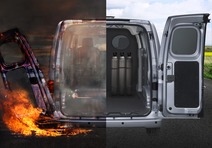

Secure it. Ventilate it. Respect it.
Transported and used correctly, acetylene is a very safe gas. However, our research shows that many users fail to follow good practice guidelines, resulting in the following potential risks:
Secure It.
Many customer vehicles are not fitted with appropriate restraints to prevent cylinders from toppling over or moving around in the vehicle. This can result in fires and injuries. There are two sources of hazard here. During transport, the cylinder handwheel valve can knock against something which opens the valve. This allows gas to escape, and can result in a fire or explosion. Also, cylinders are very heavy and will be travelling at the same speed as the vehicle. If the driver brakes and the cylinders are not adequately secured, they will be propelled forward and can cause severe damage or injury.Ventilate It.
Many acetylene cylinders are collected and transported in unventilated vehicles. In the event of a leak – no matter how minor – gas can build up in the vehicle and result in a fire or explosion. This risk is magnified over prolonged storage periods. For instance, many users – once they have finished their day’s work – leave their cylinders in an unventilated vehicle overnight. This gives gas leaks a chance to build up over time. This risk is compounded by inappropriate use of the regulator to shut off the gas supply. The regulator can easily leak so it is essential that the shut-off valve is used for this purpose.Respect It.
Acetylene cylinders contain a porous mass and liquid acetone that dissolves the gas. If a cylinder has been transported, it must be left to settle in an upright position on arrival. This gives the liquid acetone time to return to its correct place in the porous mass. Failure to do so can cause quality problems with acetone liquid getting into the gas. In extreme situations, this might make the cylinder less safe to use.